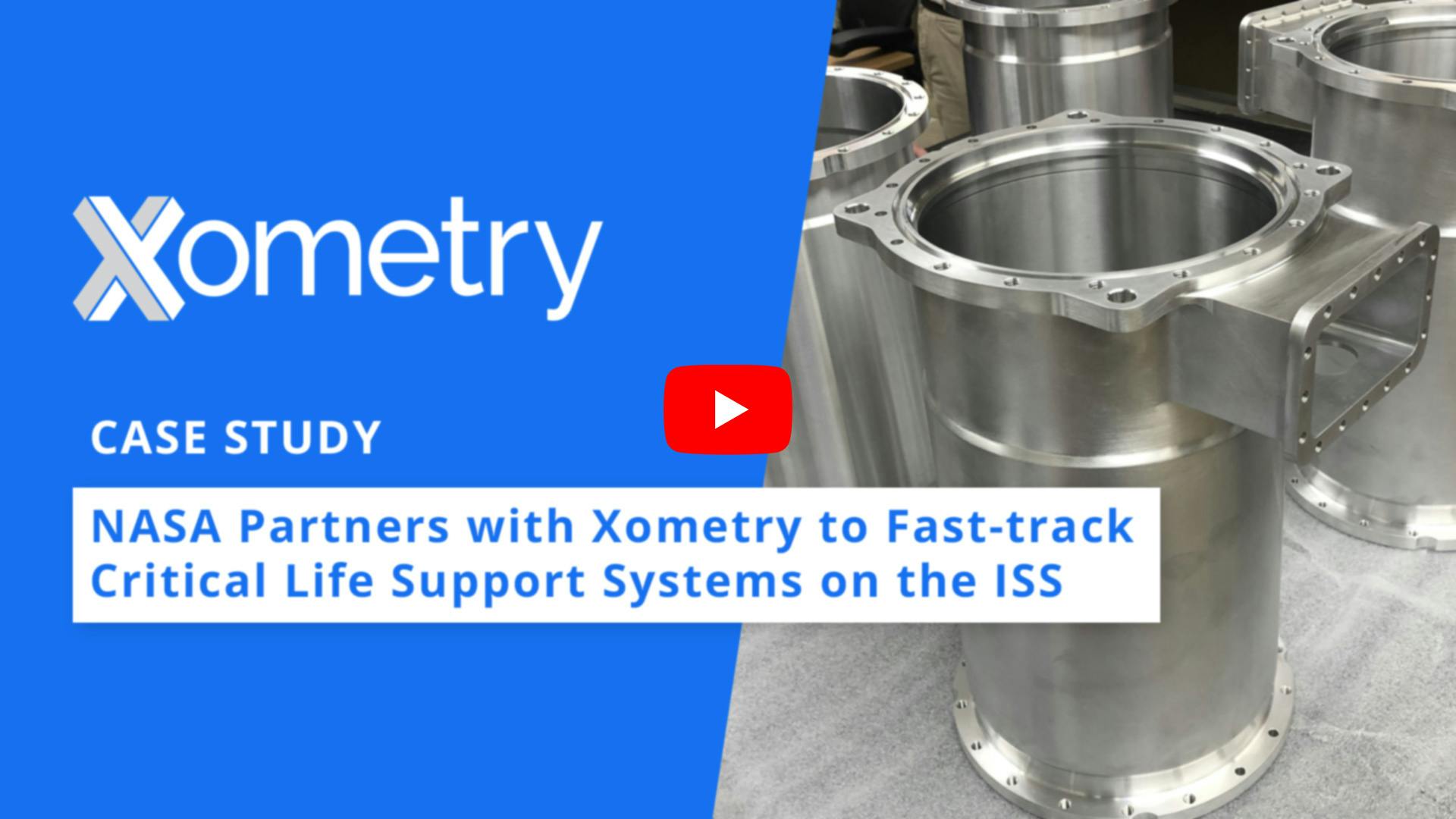
Case Study: NASA Partners with Xometry to Fast-track Critical Life Support Systems on the International Space Station
NASA engineers at the Marshall Space Flight Center employed Xometry’s large format CNC machining capabilities to build mission-critical air purification units.

| Industry | Manufacturing Services Utilized | Project Brief | Solution |
|---|---|---|---|
Industry ☑ Aerospace & Defense | Manufacturing Services Utilized ☑ CNC Machining | Project Brief NASA needed to fast-track the production of components for an air purification unit for the International Space Station. Expedited manufacturing would help the team remain on its proposed rocket launch schedule. | Solution Xometry sourced uncommonly large stock material and CNC machined 2 single body vessels with extremely tight tolerances and critical sealing surfaces—all within a 4-week lead time. Xometry reduced the projected lead time by 2 months and decreased costs by 75%, enabling future flexible and comprehensive design methodologies. |
What Do You Need to Live In Space? Recyclable Energy Systems.
On the International Space Station (ISS), critical resources are maintained in closed-loop systems. These systems replenish resources such as oxygen and water, which allows NASA astronauts to live 220 miles (350 km) above the earth.
The design, fabrication, and maintenance of these systems is the job of NASA’s Environmental Control and Life Support Systems (ECLSS) team. The latest project that ECLSS engineers at the Marshall Space Flight Center (MSFC) in Huntsville, Alabama, are working on is an air purification unit that will scrub carbon dioxide from the air via a desiccant (a material that draws water from air) and a molecular sieve (a material that traps and expels carbon dioxide molecules outside the space station). This system is known as the Four Bed Carbon Dioxide Scrubber (4BCO2) system.

The Challenge: Building Extra Large Flight Components at Record Speeds
Over the last 2 years, the design of the 4BCO2 system has progressed using a multi-part design for the cylindrical bed hardware. This design required the parts to be welded together. As the manufacturing process began on the cylindrical beds—the foundational components of the system—ECLSS engineers ran into a problem. It was determined that the welding operations (the best method for NASA’s in-house capabilities), would introduce delays due to a lengthy weld certification process. This posed significant risk to the team’s ability to meet their hardware delivery schedule.
Due the schedule risk, the ECLSS team decided to abandon the welded design and associated weld certification process and explore other design options. Redesigning the parts by reducing the size of the beds was not an option as it would compromise the system’s functional performance. Instead, the team decided on a one-piece barrel design. This decision required the fabrication to be outsourced in order to get the priority needed to maintain schedule. The 4BCO2 team, led by NASA engineer Jimmy Hill, reached out to Xometry to see if the company could handle this highly custom job.
CAD assembly of the air purification units
A Highly Custom CNC Machining Solution
Hill spoke with Xometry’s dedicated account representatives about the project requirements and timeline, emphasizing that the project was now behind schedule. Hill requested a 4-week turnaround, which would involve sourcing a specialized, large-format CNC machine shop in Xometry’s ITAR-certified network.
Within the allotted 4 weeks, Xometry secured rare, specialty heat-treated, cylindrical aluminum stock as well as a Manufacturing Partner to make the 12” by 16” diameter parts. The parts were carefully machined to aerospace standards, including tight tolerances of 0.005” and accuracy to GD&T. Critical sealing surfaces of the pressure vessel were machined with o-ring grooves, close-fitting parts, tight side and positional control tolerances, and highly accurate tapped and thru-holes.
The Xometry inspection team verified the parts via CMM inspection before passing the parts on to NASA for the verification testing process. From there, the parts passed all of NASA’s individual material tests as well as the full integration tests.
Xometry CNC machined 4 vessel components to make 2 air purification units for the NASA International Space Station

Xometry Manufacturing Is Changing the Way NASA Develops Parts
With help from Xometry’s on-demand manufacturing services, the air purification unit developed by NASA’s ECLSS team is on track to go up in the Cygnus rocket during the NG-15 launch in 2021. Xometry’s turnkey services reduced what would have been a 3-month in-house production timeline to just one month, preventing a domino effect of delays.
Hill says that Xometry’s market-accurate pricing and supplier management allows NASA to save 3-4 times the projected cost of in-house manufacturing. And because of the high-cost savings, the team’s development methodology can shift from linear prototyping to a more lean, parallel prototyping methodology. This has the effect of dramatically reducing project lead times.
“We typically have a lot of internal overhead with paperwork and personnel costs, but Xometry’s time-saving supplier management passes on savings to us. Xometry has capabilities that we don’t have in-house, and is so fast and cheap that we don’t mind paying for 2 or 3 [flight equivalent] versions at once. This helps us gain time in our schedule,” says Hill.
With the success of the air purification unit and various other jobs, NASA teams across 10 US facilities are confident that Xometry can take on mission-critical work for all types of machined, sheet metal, or 3D printed parts.




